I remember the shift from multiple choice reading assessments to constructed response reading questions like it was yesterday. When we first made the shift, we got everything from blank stares (because they didn’t understand the question), to single-word answers, simple phrases, off-topic answers, and let’s not even talk about grammar and spelling. Hint: It was rough. 😛
My grade-level team and I had to come up with a plan and fast. One strategy we implemented that made a huge difference was teaching the students to use the RACE acronym when answering constructed response questions. However, there were some learning curves, as with any new strategy. This post will break down the RACE strategy, why I chose this strategy, and tips for each part of the strategy.
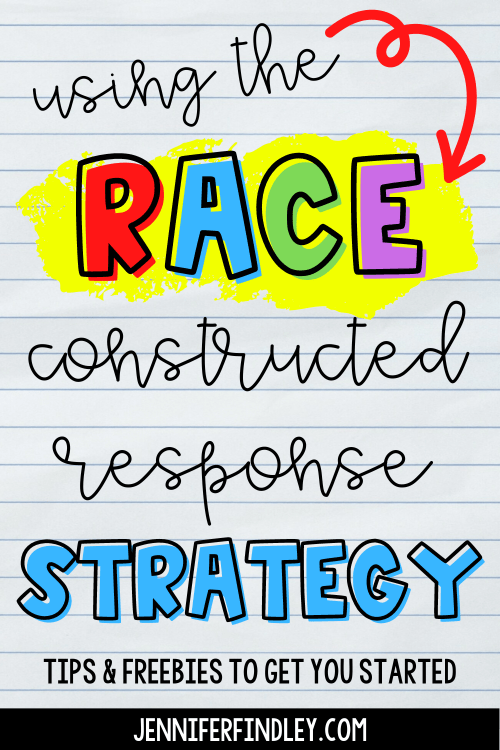
Why Use The RACE Strategy for Constructed Response Reading Questions?
First, RACE is an acronym that helps guide students through the process of answering constructed questions in reading. The RACE acronym stands for:
R – Restate the question.
A – Answer the question completely.
C – Cite evidence from the text.
E – Explain the text evidence.
There are many different constructed response strategies and acronyms that are available to students. I chose to use the RACE strategy because of the importance put on restating the question and the fact that the students have to take their answer a step further by explaining how the evidence they cited supports their answer.
With that being said, any acronym and constructed response strategy you teach will work if you teach each step strategically and support students as needed. How do you do that? I am glad you asked…keep reading for all my tips and my recommended resources, including freebies.
Tips for Teaching Constructed Response with the RACE Acronym
1.) Practice with short texts specifically to teach the RACE strategy FIRST. Introducing it in a nonthreatening way with short texts will allow the students to learn the process and importance before moving on to lengthy grade level texts.
2.) Start the year off teaching the RACE strategy (or whichever constructed response strategy you choose), so your students have all year to practice it. The sooner the better. Please don’t try and implement this in the weeks leading up to the test. #spokenfromexperience
3.) Embed the use of the RACE strategy in read alouds and guided reading throughout the year. One easy way to do this is through sticky note evidence collection. For example: “In this section, we learn just how greedy the character is. Look for evidence in the text to support this conclusion.” The students flag or jot down the evidence and then we discuss it and sometimes compile it into written responses using the RACE acronym.
4.) Teach each step in the RACE strategy on its own and let them build on each other. I teach R (restating the question), and we practice. Then, we move on to A (answering the question completely), and we practice and talk about the importance of using complete sentences, making sure we answer all parts of the question, using key vocabulary, etc. That usually takes one day, but sometimes two. The next 2-3 days focus on teaching C and E (how to pull relevant evidence, cite that evidence, and then explain it). The C and E are the ones that we spend ALL YEAR practicing and refining.
5.) Teach the students to write the acronym on their paper beside each question AND check off each part as they complete it. I do give my students posters and bookmarks to remind them of each part (see Tip #7 for freebies), but ultimately, the responsibility needs to be on the students because they can’t use those resources on state assessments.
6.) Another tip that I have done is to have the students color code the different parts of their response. This is an engaging way for the students to make sure they include everything needed. I like to do this every now and then throughout the year, and my students love it.
Grab the RACE Strategy printables shown here for FREE!
7.) Scaffold the students with reminders. This can be done through bookmarks, RACE strategy posters glued into reader’s notebooks, RACE anchor charts hung in a prominent location, or by creating RACE toolkits with bags, containers, or by putting the RACE strategy posters on a ring.
R – Restate the Question
I learned several years ago that my students need explicit practice with this part of RACE. One way that I do is this is through lots and lots of practice, but I also like to incorporate some fun activities.
One of the activities I use are these Restate the Question puzzles. The students have to read the question puzzle piece and find the restatement that matches. The questions are all focused on reading standards, so it will be a nice review of key vocabulary, as well.
Another activity that my students really enjoy is my Restate the Question Bingo. The students really enjoy playing this and even request it when we have a few extra minutes to spare.
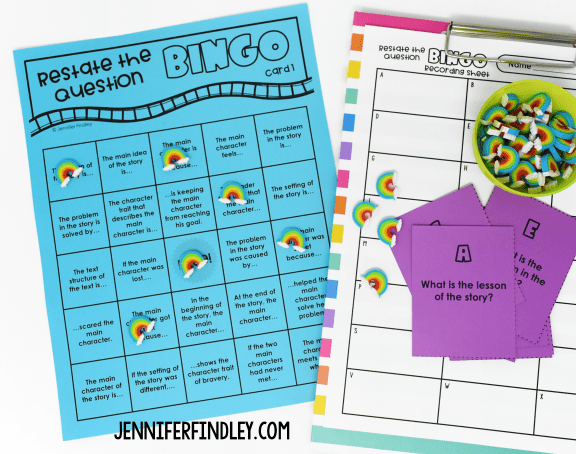
Besides teaching this skill explicitly and reviewing with the activities above, here are two more ways that I help my students:
- Have them answer questions verbally in complete sentences. Just doing this simple strategy throughout the year will make a huge difference in their ability to restate questions in complete sentences in a written format.
- Have the students restate the question orally and in writing (leaving the answer part blank) before they even begin to answer the question. We do this with math constructed response tasks, too, and it makes a huge difference in ensuring the students understand what the question is asking them.
A – Answer the Question Completely
This one is pretty self-explanatory, but one thing that I do for this that really helps is have my students check off the question as they answer it. This really helps ensure they answer the question completely if there is more than one part. They simply place a small check mark above the part of the question after they have answered it.
I also teach my students the importance of ensuring they use vocabulary from the text and don’t use pronouns for characters until after they have introduced them in their response.
C- Cite Evidence from the Text
Citing the textual evidence is the part of answering reading constructed response questions that can be the trickiest. Here are the strategies we use:
1. I teach several mini-lessons that focus specifically on finding and collecting textual evidence to support points, inferences, or answers. I do these mainly through our read alouds so it integrates nicely. I use these two text evidence printables that are included in the RACE toolkit also linked above.
2. When we use passages, my students are taught to underline the evidence from the text that supports their answers.
3. I explicitly teach the different ways to cite evidence from the text. I do teach both types but, honestly, I prefer to have my students paraphrase the evidence in their own words. This keeps them from plagiarizing and having an answer that is not their original thoughts.
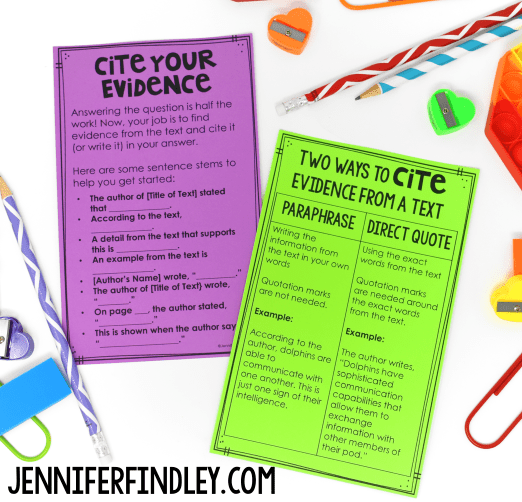
4. Provide sentence stems for the students to use when they are citing their evidence.
5. Teach my students the power of 3. This means that they try to provide three pieces of evidence to support their answer. We do talk about how sometimes three pieces of evidence may not be available. However, teaching them the power of 3 and that the more evidence you provide, the more difficult it is to refute the answer keeps them searching for more relevant evidence to use.
If you need several engaging resources in a variety for formats for teaching students to find and summarize text evidence, check out this resource!
Shop This PostText Evidence Activities | Citing Text Evidence
Finding text evidence and citing text evidence are two reading skills that need to be modeled, practiced, and spiraled all year for our students to truly be successful. This huge resource is a bundle of SEVEN text evidence resources. Each resource provides rigorous practice with inferring, finding text evidence, and summarizing that text evidence.
E – Explain the Evidence
This step was the bane of my existence for a long time. For the life of me, I could not figure out a way to help my students explain their evidence without just restating it.
Finally, I had a light bulb moment and came up with two strategies to help.
1. I taught the importance of not only providing valid evidence but also explaining it using a detective analogy. As a class, we discussed how a detective collects all of the evidence but doesn’t just plop the evidence down on his boss’s desk. He has to explain how each piece of evidence proves his case.
2. I also came up with some simple sentence stems that would both help my students explain their evidence and show them the importance of explaining it to begin with. The stems helped them understand that they need to show why the textual evidence even matters through their explanation.
Click here to grab the posters I use for helping my students explain their evidence.
********
Want more tips for answering constructed response reading questions? Click here to read even more tips for helping your students master answering constructed response reading questions.
Do you use the RACE strategy for constructed response reading questions? Or another constructed response strategy? Let me know in the comments. I love hearing all of the different strategies teachers use.
And don’t forget to grab the free charts and posters to make your own RACE toolkits to help your students master reading constructed response questions by clicking here.
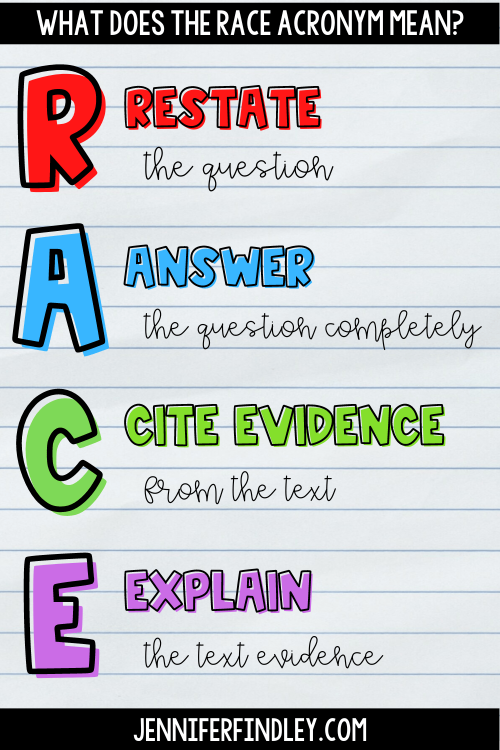
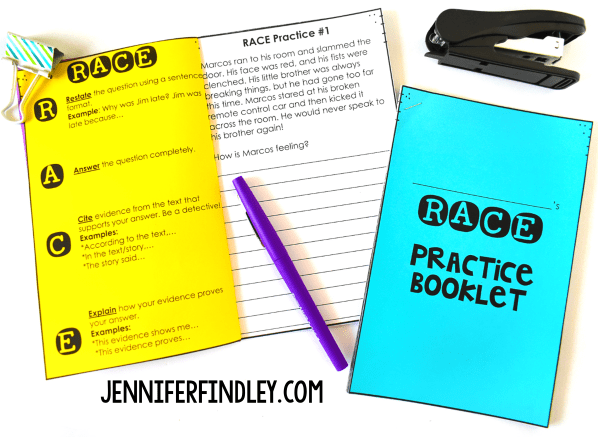
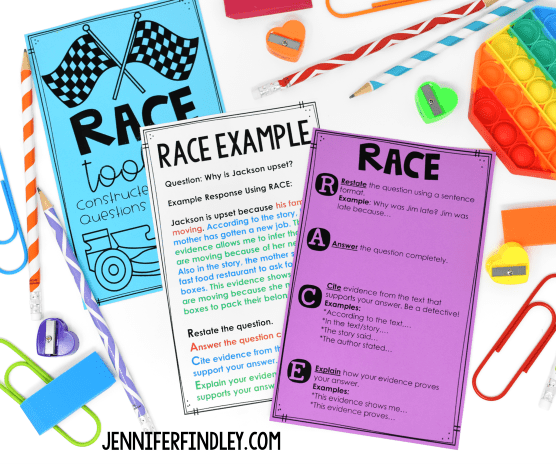
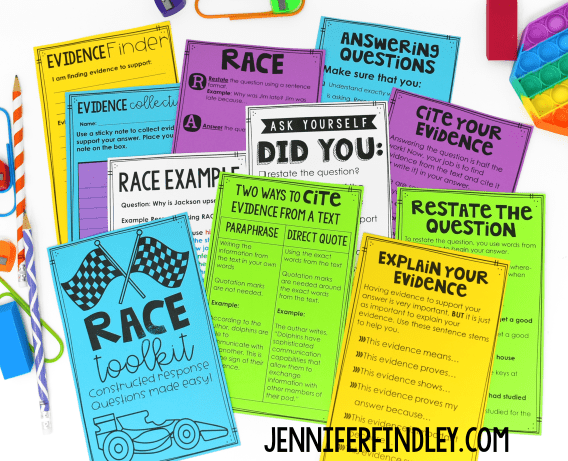
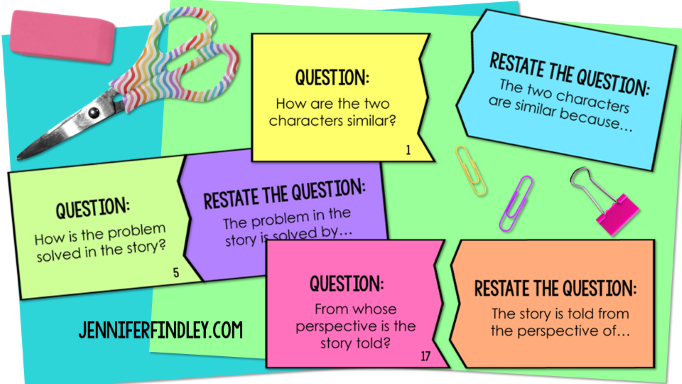
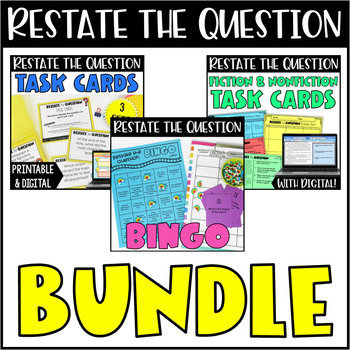
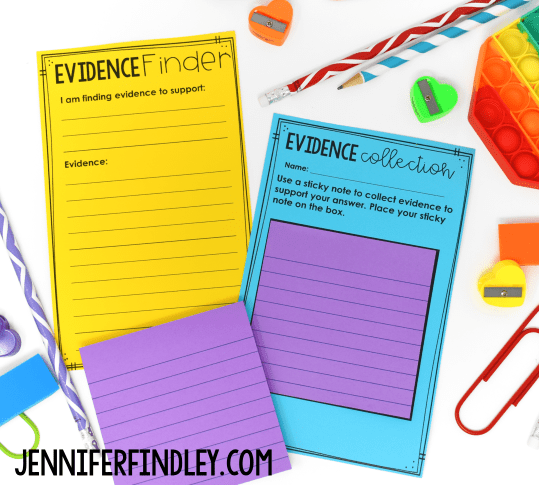
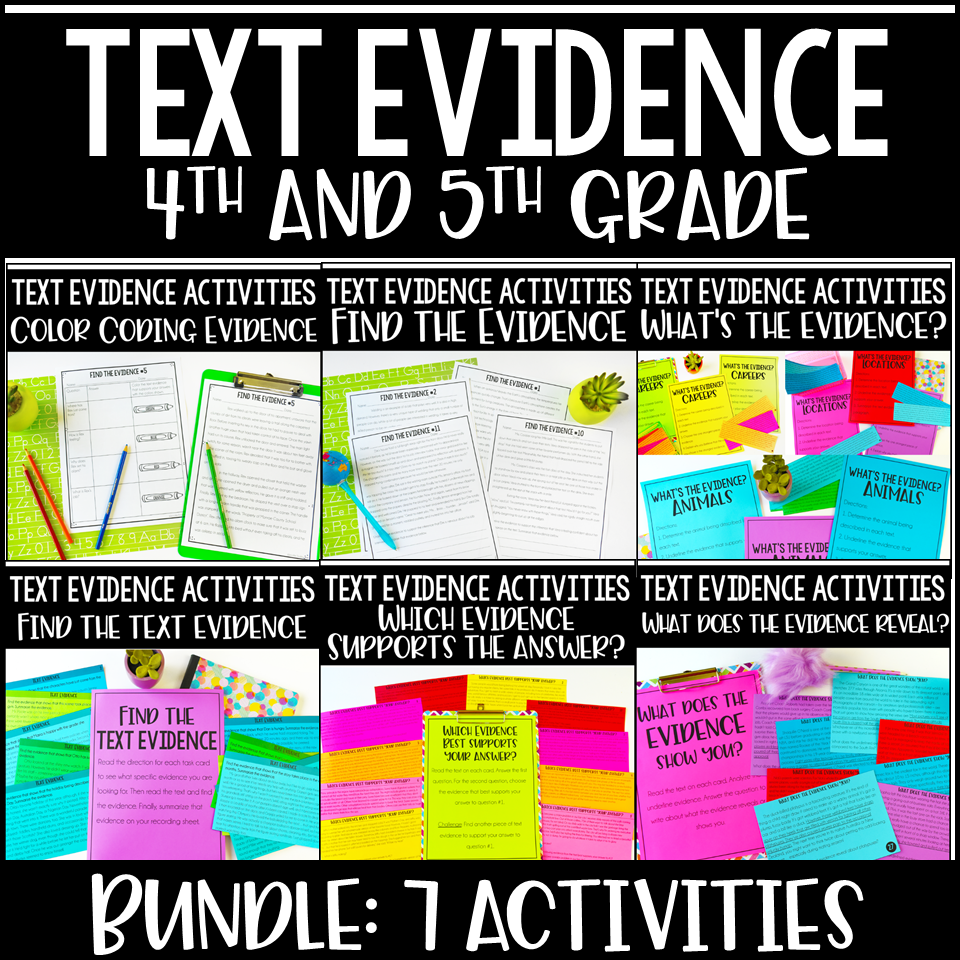
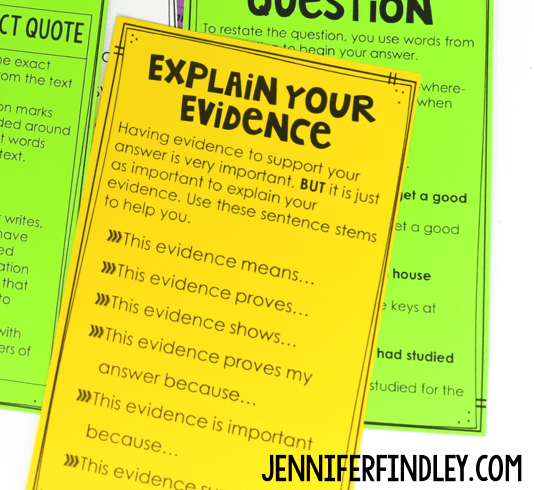







Thank you for the RACE mini book! I use RACE in my class and we even added an S to the ending, so that students understand to end with a strong thought to keep the reader thinking about the topic.
I can’t seem to find the RACE Question puzzles?
Me either
You have to subscribe to the blog page to be sent the puzzle’s 🙂
Hi! I am a third grade teacher and use a strategy that I came up with called, “R.A.T.S.” (Restate, Answer, Track down evidence, & Summarize & connect.) It is a younger, kid friendly method for grades 1-4 with motions to help kiddos remember the important parts of forming their constructed response answers. Feel free to check it out at my tpt store; http://www.teacherspayteachers.com/store/Oceans-of-Ideas-Teaching-with Jen. I would love your suggestions or feedback. Thanks for sharing your strategy with us!
I am not a teacher; I am the parent of a child in elementary school. My child has been given an assignment in which he is to use the RACE strategy. The assignment simply consist of a question that asks what does one think a specific quote means. How would you answer this, using the RACE strategy, when there is no additional text?
Hi Debbie, for this example, the evidence that he or she would cite would be a combination of words/phrases from the quote and background knowledge. Here is an example:
“I have a dream that my four little children will one day live in a nation where they will not be judged by the color of their skin, but by the content of their character. I have a dream today.”.
To me, this quote means that Martin Luther King wants people to not be judged by race but instead by how they behave and treat others. The evidence from the quote that supports this is when King says “not judged by the color of their skin.” This phrase shows that he does not wish for people to be judged based on their race. Also, he says “by the content of their character” which means the kind of person they are on the inside and how they treat others.
The C is pulled from the quote itself and the E is pulled from the interpretation of the evidence.
Hope this helps!
As stated below the RACE strategy puzzle picture, “To get these Restate the Question puzzles for free, simply join my email list using the form below. Due to the nature of the questions and reading vocabulary, these are best for 4th and 5th graders,” I entered my email, but I did not receive an email back regarding the free item. Please advise how I may receive the puzzles.
Thanks so much.
Hi Rona, just sent you an email. 🙂
Want to learn about the RACE strategy
Hi – Could you also send me the freebies to my email? The auto-responder did not work.
Hi Anita, I am showing the email was sent. Were you able to access it?
Hi Jennifer,
Loving your stuff! Like some of the others above, I couldn’t find the Restate the Question Puzzles in the freebies. Can you send me a link or tell me exactly where I might find them?
Thanks in advance,
Darrin
Got the 2nd email and the puzzles – thanks!
hi, I am a student and im wondering why is the race strategy important how can it help us in the future because im want to animate when im older.
Hi Jennifer! 👋
Do you have any tips for the restate/answer piece of RACE? My kid’s want to write them as two separate sentences, but I feel like they should be one. Sometimes I can see them being two sentences…but not really? …Any suggestions?
Thanks!
Kaitlin
Hi Kaitlin,
My students restate by writing a cloze sentence and answer by turning it into a complete sentence. Jennifer, I hope you do’t mind me chiming in.
Is there a text that goes along with your exemplar writing in the tool kit?
What mentor text do you use to teach this strategy? I read someplace that you start out with a mentor text. Since I use mentor texts to teach with, I would like to know what you use.
I found this blog very useful! I am also interested in freebies.
This so cool! This website is VERY reliable. I am actually a 7th grade student, and we’re doing CRQ’s. This really helped me out! Thank you!
I love your material!! We use RACE in 3rd grade this year. When the students are struggling to restate and answer in the same sentence, how do you navigate that and direct them? 3rd grade has more beefy responses and sometimes restating and answering in one sentence doesn’t make sense. Any suggestions? Thanks!! Also, I’d love your freebies! Unsure if I need to subscribe somewhere or you add me to a list!
Hello, I am wondering if you would use RACE with all types of writing responses (opinion, informative, and narrative).
Thank you so much!
Lisa Pruitt
Get a wonderful membership on watching group sex of hot babies😍.girlsway promo codes
bro what